- You are here:
- Home »
- Cauchi
Tag Archives for " Cauchi "
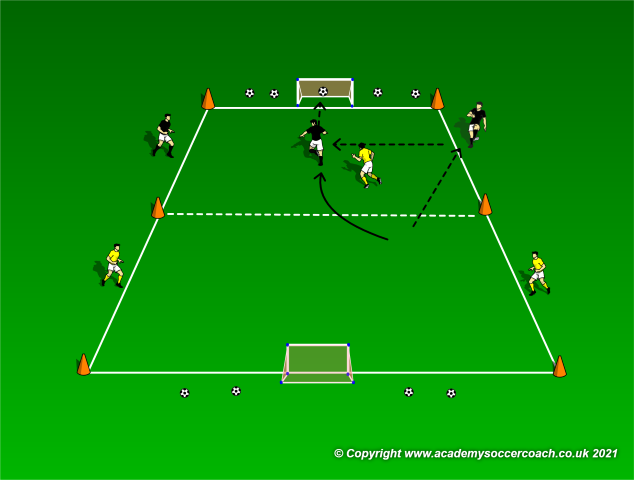
1 Plus 2 v 1 Endurance
By Philip Cauchi
Title of practice: 1+2 v 1 Endurance.
Type of practice: High Intensity Interval.
Age bracket: Under 12 upward.
Area of practice: 15 yards by 10 yards divided into two equal vertical zones.
Aim of the practice: To develop muscular endurance in the duel. The players are required to perform a high number of soccer actions, both on and off-the-ball and both in the attacking and defending phases.
Number of players: Two teams of three players each. One player from each team working and the other two on the perimeter recovering actively.
Workload: Blocks of thirty seconds each with a period of one hundred to one hundred and twenty seconds of recovery in between. The number of blocks vary according to the period of the season we are in and also to the soccer fitness level of the players.
Description of the practice:
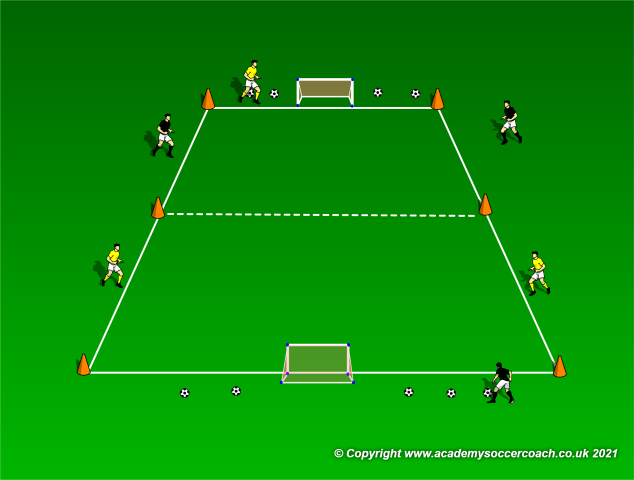
Both the player starting the attack and the defender start from their own goal lines close to the goal they are defending. In the opposing half of the practice area the attacking player has a support player on each side. The support players are the players actively recovering between blocks.
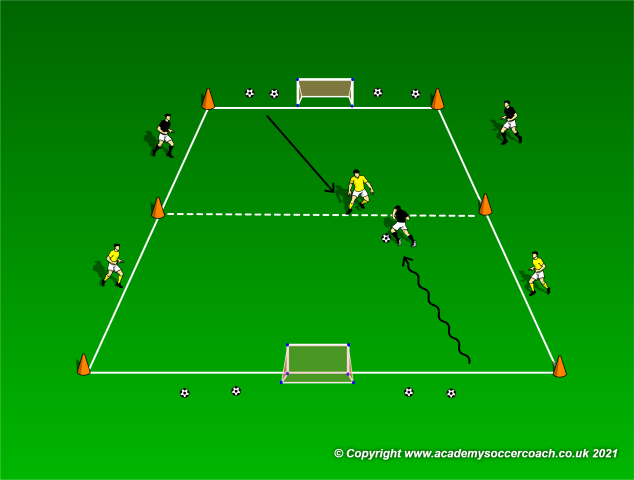
The attacker dribbles the ball forward and can only score from inside the defender’s half of the practice area. Immediately after the attacker starts the attack, the defender becomes active.

The attacker can decide to dribble past the defender or combine with any of the supporting perimeter players to score. Should the defender win the ball she counters on the opposite goal from inside the opponent’s half.
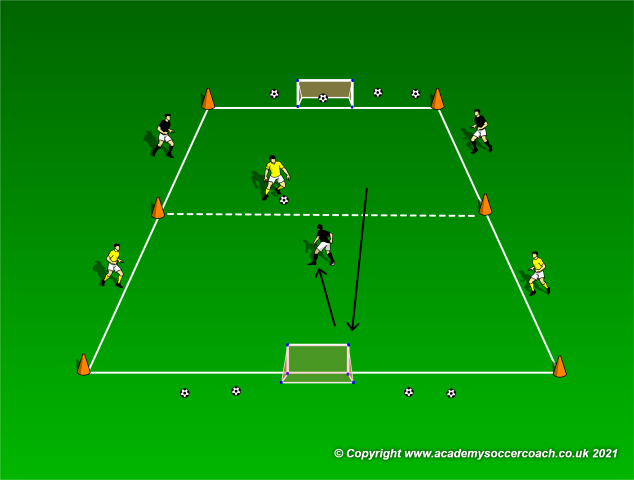
If a goal is scored the defender who suffered the goal sprints back to her goal line to take another ball and initiate the new attack. The attacker now becomes the defender and sprints back to touch her mini goal post to then defend against the new attacker. This procedure also occurs if the ball goes out of play. In this situation the player who made the tackle and won the duel is rewarded by restarting play as described.
Progression 1: Instead of restarting play in the way described above. The player who is now on the attack receives the ball from one of the two teammates on the perimeter (the player should be pre identified before the start of the exercise) to simulate a quick counter attack.
Progression 2: As in progression one but the coach restarts the game by putting another ball in play.
By Philip Cauchi
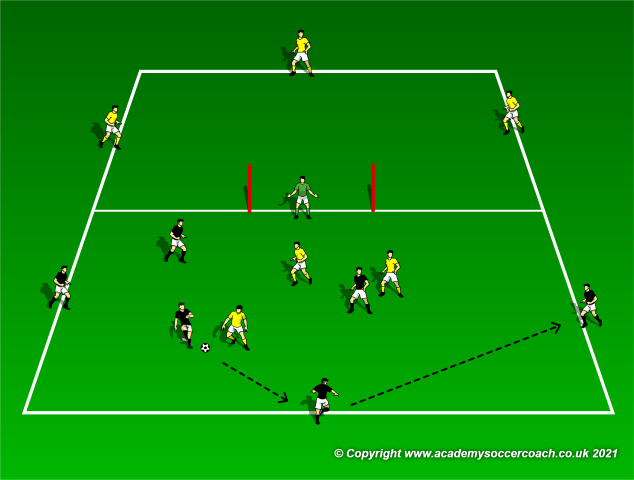
3+3 v 3 Continuous Transition Game
By Philip Cauchi
Title of practice: 3+3 v 3 Continuous Transition Game.
Type of practice: High Intensity Intermittent.
Age bracket: Under 14 upward.
Area of practice: 35 yards in length by 20 yards in width divided into two equal vertical zones. This however depends on the tactical-technical and also the soccer fitness level of the players.
Aim of the practice: For the players to be quick on moments of transition, both negative and positive.
Number of players: Each team has three players inside and three players on the perimeter.
Workload: 6 to 8 blocks of two to four minutes (depending on the level of soccer fitness) each with a recovery period of two to four minutes. During the recovery period the inside players switch their role with the outside players.
Description of the practice:
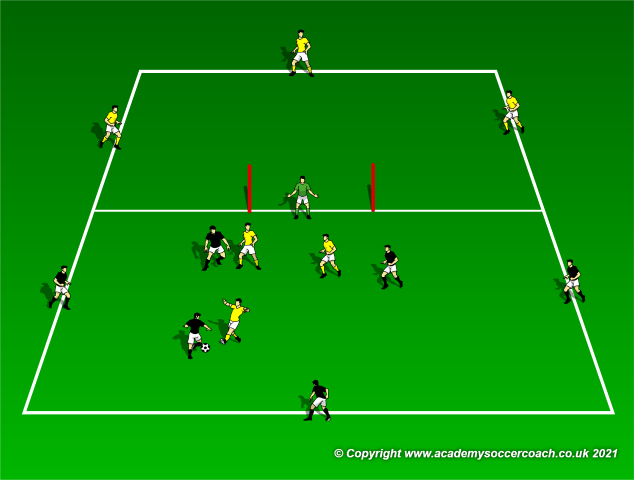
Each team has three players positioned on the perimeter in their own half of the practice area. A central goal marked by poles is guarded by a goalkeeper who is neutral. When playing in their own half of the practice area, the team in possession plays with a numerical advantage of 6v3. Teams can only score from inside their own half.

The team in possession uses the perimeter players to secure possession of the ball and to find the right moment to finish on goal. They can only score from their half of the practice area. The perimeter players may be allowed to score. However, if we want the inside players to work more on getting unmarked and thus also increase the intensity level (tactical-technical, mental, physical and psychosocial) the perimeter players should not be allowed to score. As the load of the perimeter players is low they will be actively recovering. An active recovery (performing light work) allows for a faster recovery than passive recovery (doing nothing). The team without the ball aims to recover the ball and play it to their teammates in their half.
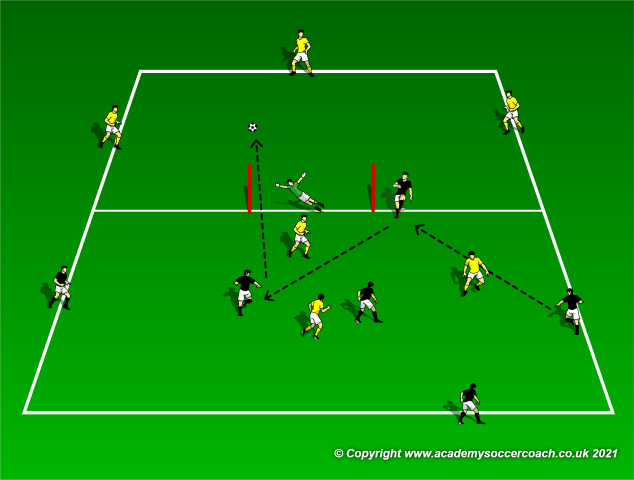
A goal is scored and the ball gets to the opposite half. The other team now has the ball and are on the offensive. This also goes if the ball was shot wide of the goal. The team that scored the goal must quickly react to the change of roles (negative transition). If the team hadn’t scored and the ball was saved by the goalkeeper, he passes the ball to the defending team in the opposite half of the field.
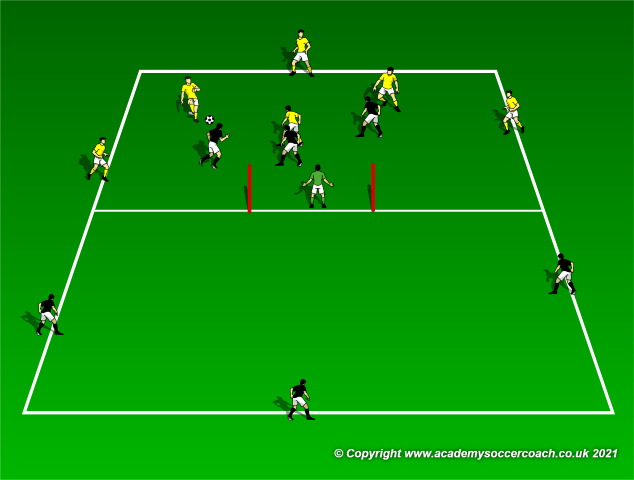
Both teams must quickly move into the opposite half of the pitch. The new team in possession of the ball must have all of its players inside their own half before they are allowed to score. For the team who now has to defend, if their players are not all inside the opponents’ half if a goal is scored, the goal counts double.
By Philip Cauchi
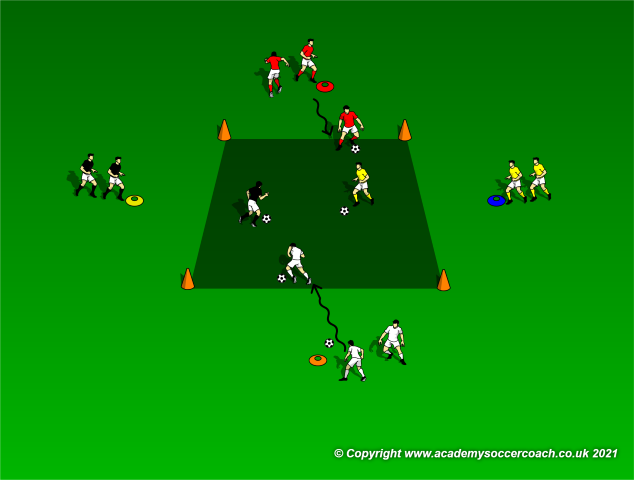
Ball Gladiators Warm Up and Conditioning Game
By Philip Cauchi
Title of practice: Ball Gladiators.
Type of practice: Warm-up
Age bracket: Under 8 to under 13.
Area of practice: 12 yards by 12 yards.
Aim of the practice: The players will be aware of when and how to shield the ball to protect it, play with the head up and continuously assess their surroundings, and also to learn when to time to tackle to dispossess an opponent of the ball.
Number of players: Four groups of three to four players each.
Workload: Continuous play for five minutes with continuous changes of players during the game.
Description of the practice:
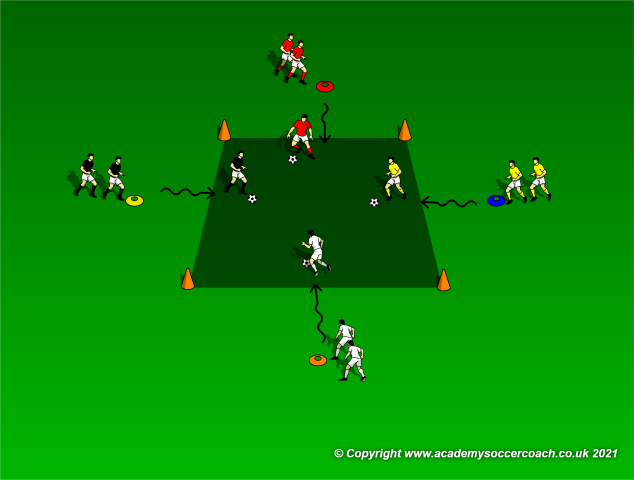
Four groups of players where each group is positioned three yards outside a side of the marked practice area. The first player in line of each group dribbles the ball into the practice area.
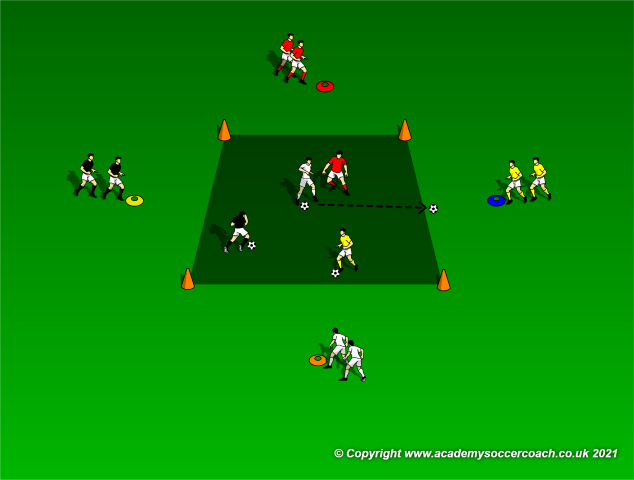
Play is all v all where each player protects her ball and aims to kick any of the opposing three players’ ball out of the area. If successful the player earns a point for her team. As a variation we can also include that the player who had her ball kicked out of the area loses a point for her team. The player who had her ball kicked out of the area cannot kick someone else’s ball. However, the player who kicked her ball can also have her ball kicked out of the area. This forces the players to identify the right moment to tackle any other player’s ball while keeping their ball protected.
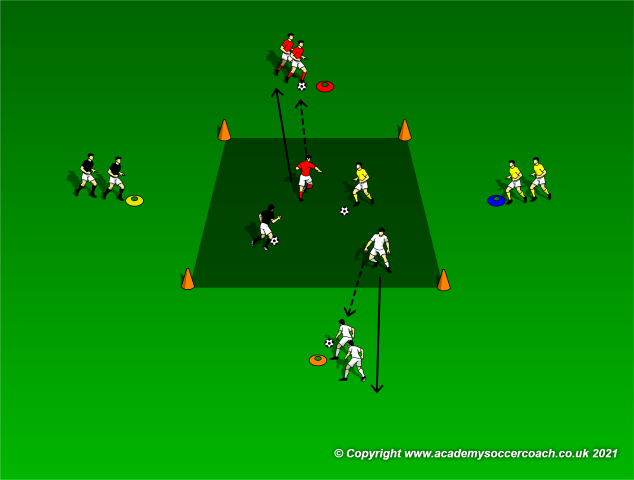
Both the players who kicked the opponent’s ball out of the practice area and the player who had her ball kicked out swap places with the next player in line in their group. This eliminates the risk of having one player staying all the time inside with the ball with her teammates being static for the majority of the practice time.
Should the players remain for more than thirty seconds inside, the coach may shout the letter, number, color, etc of their group to switch with the player next in line. We can also have a rule that if a player stays standing inside without doing anything for thirty seconds or more has a point reduced for her team.

The players next in line of both groups dribble the ball to join the other two competitors.
By Philip Cauchi
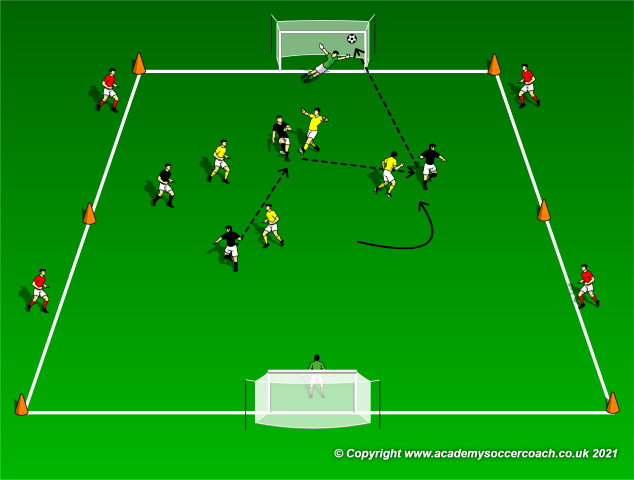
Team In Team Out Continuous Play
By Philip Cauchi
Title: Team in – Team out: Continuous play.
Area of practice: 30 yards by 25 yards.
Number of players: Two goalkeepers and twelve outfield players. The outfield players are divided into three groups.
Workload: Continuous play for eight minutes with a rest period of three minutes in between series. Play three of four series depending on the level of the soccer fitness of your players.
Description of the practice:
Two groups start playing against each other as in a normal game. Each group/team attacks one goalpost and defends the opposite. A goalkeeper is assigned to each team. The third team act as neutrals and are positioned on the side lines as shown in the diagram below. When one of the two teams score, they retain the ball and immediately counter on the opposite goalpost. In the meantime the team who were neutral must immediately switch roles with the team that conceded the goal.
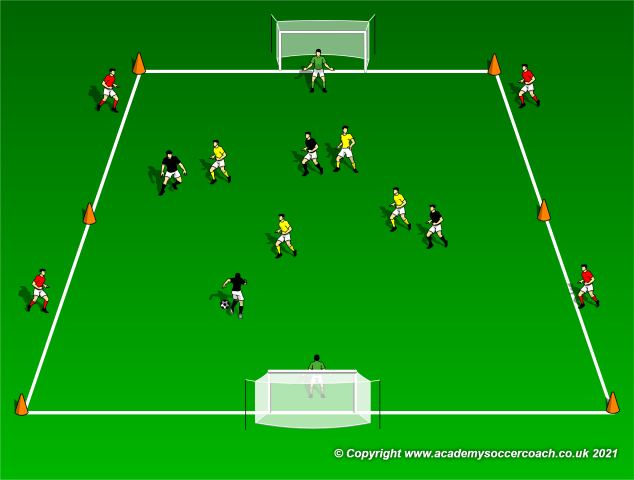
The two teams start the practice as a normal game where they attack one goalpost and defend the opposite. The neutral players on the side lines help the team in possession to secure the ball but are not allowed to score. This forces the players of the team in possession to create and exploit space in order to be able to finish on goal.

One of the team scores and retains possession of the ball. Immediately the team who suffered the goal switch places with the team who is actively recovering by acting as neutrals on the side lines.
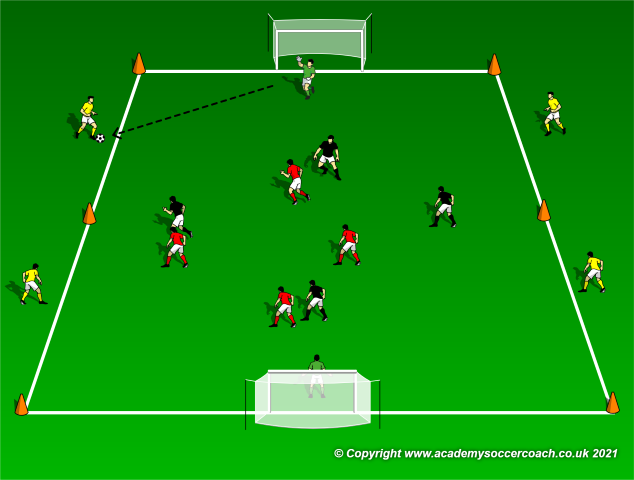
The team that scored attacks in the opposite direction. All the players must quickly react to the change of the situation by adapting their position on the field of play accordingly.
By Philip Cauchi
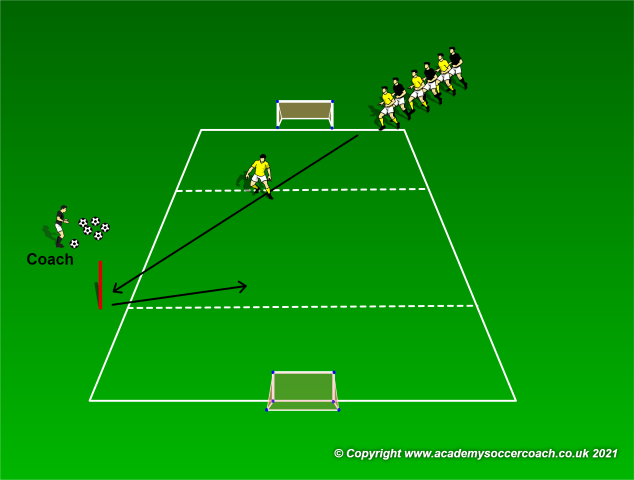
Transition 1v1s
By Philip Cauchi
Title: Transition 1v1s.
Area of practice: 15 yards by 12 yards.
Number of players: Six to eight players maximum.
Workload: Work continuously for five minutes with the players rotating all the time. Therefore the players rest between repetitions as part of these five minutes. Perform twice (2 x 5 minutes with a recovery period of two minutes).
Description of the practice:
The first player in line sprints to touch the pole positioned at the side of the practice area. Immediately the coach passes the ball to the next player in line to start the 1v1. The player to whom the coach passed the ball attempts to score in the south goal while the opposite player attempts to score in the north goal. Players may only score from inside their respective scoring zone. After the attack is over, the player who attacked the south goal sprints to touch the pole while the coach passes a ball to the attacker next in line. This player attacks the south goal while the player who previously attacked the south goal now defends it and attacks the north goal.
Key points:
The attacker should attempt to attack the goal at speed while using fakes to fend off the defender.
The defender should get between the goal and the player with the ball and force him/her wide into a narrow angle.
On the positive transition the player who recovered the ball should immediately explode into the space in front of her to attack the defender’s goal and not to give her the opportunity to recover.
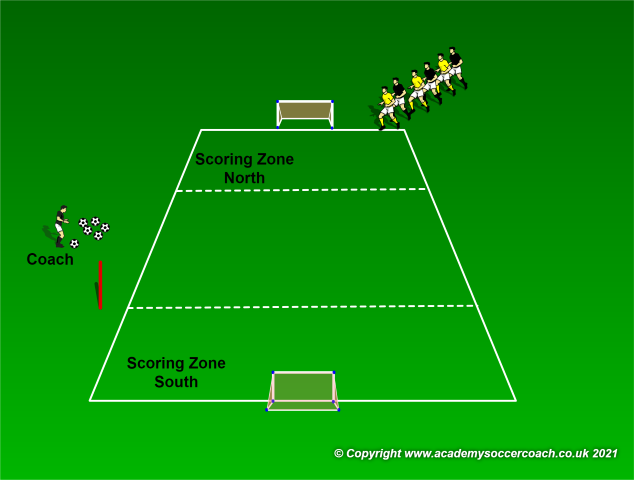
The players are organized in a line as shown in the image above.

The first player in line sprints to touch the pole positioned just outside the area.
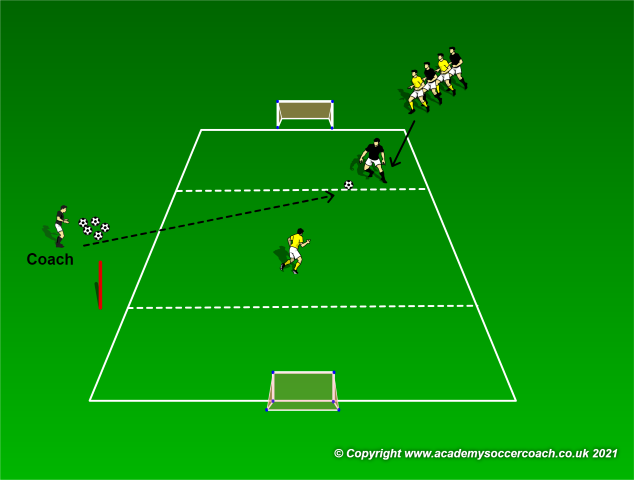
Immediately the coach passes a ball to an attacker who aims to get past the defender and score in the mini goal post.
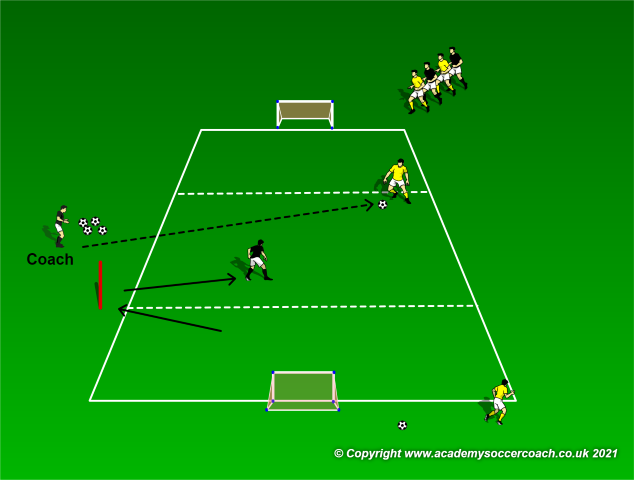
When the action is over the player who previously attacked the south goal, sprints to touch the pole to then defend the same goal against a new opponent. The defender aims to recover the ball and counter attacks on the north goal.
By Philip Cauchi
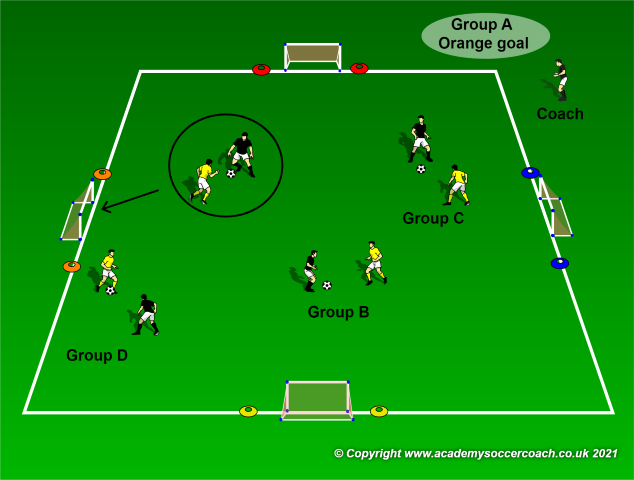
Crazy 1v1s
By Philip Cauchi
Title: 1v1s all over the place.
Area of practice: 20 yards by 20 yards.
Number of players: Eight players grouped into four pairs.
Workload: 2 sets of 6 repetitions x 30 seconds each repetition with a 90 seconds rest between repetitions and three minutes rest between sets.
Description of the practice:
The practice starts by having each pair passing the ball back and forth between them. The coach then calls each pair individually (pairs are identified with letters such as group A, group B, etc.) and the mini goal post they have to attack and defend. The player on the ball will immediately try to score in the assigned goal why the defender aims to recover the ball and score in the same goal.
Key points:
- The players should be aware of their position in relation to their assigned goal immediately after it is indicated by the coach.
- The player on the ball should immediately take the initiative to attack the goal before the defender can recover.
- The attacker should use fakes to shake off the defender as well as quick changes of speed and direction with the ball.
- The defender should get between the goal and the player with the ball and force him wide into a narrow angle.
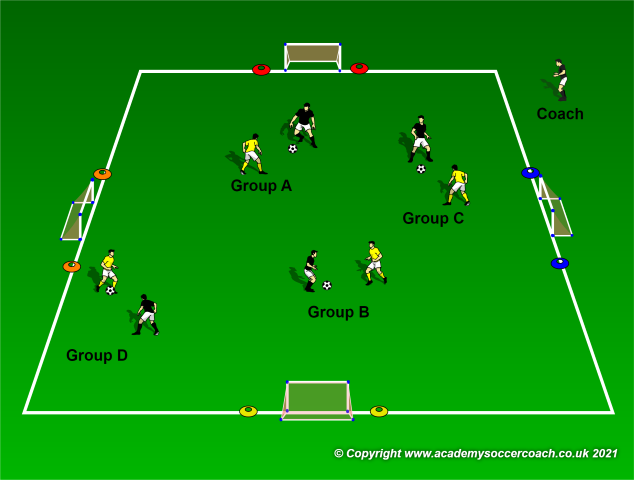
The practice starts by having the players grouped into pairs and passing the ball back and forth to each other.

The coach calls out a group and the goal post they have to attack or defend.
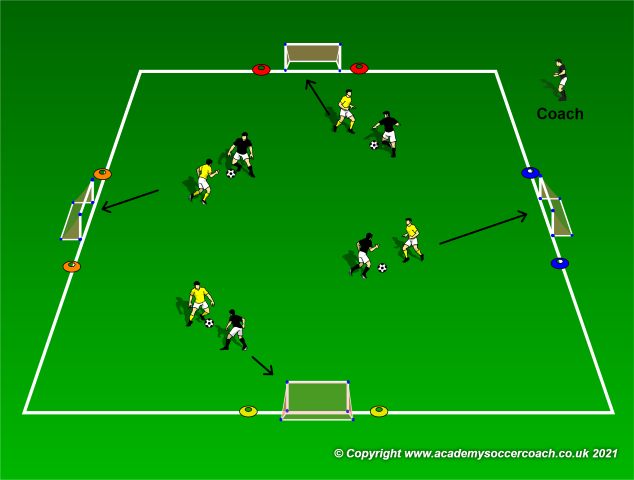
Each pair is finally assigned a goal to attack or defend. Each repetition continues approximately for thirty seconds. After each repetition, the coach calls out a new goal for each group to attack or defend.
By Philip Cauchi

Soccer-specific high intensity endurance
By Philip Cauchi
Title: Soccer-specific high intensity endurance
Aim: To develop the players’ ability to perform many quality soccer actions per minute.
Introduction: The following practice develops the players’ ability to perform many soccer actions per minute but also for them to quickly adapt and adjust their position according to the needs of the team in a specific situation. The communication channels between the players, both verbal and visual will be overloaded. The below training load is just an example. The training load should be adjusted according to the physical conditioning level of the players. It should also be taken into consideration the load of the session as a whole, this exercise and the rest of the training session. This exercise should not be carried out in less than seventy two hours following a match, as the body needs to be adequately recovered from the metabolic stress, and in not less than seventy two hours prior to the next match as we require that our players will be totally fresh.
Training load:
Area of practice: A square with the sides measuring 25 to 30 yards.
Sets: 1.
Repetitions for each set: 5 to 8.
Duration for each repetition: 4 to 6 minutes.
Rest between repetitions: 2 to 3 minutes.
Rest between sets: 3 to 5 minutes.
N.B. During the practice the team positioned on the perimeter will be actively recovering.
Description: We will go through this exercise a step at a time with the guidance of the respectives diagrams.
Below is the setup of the pitch. Each side is marked in a different color using markers. A number of balls are positioned beyond each side to allow for a better flow of the session. Two mini goal posts are positioned on each side.
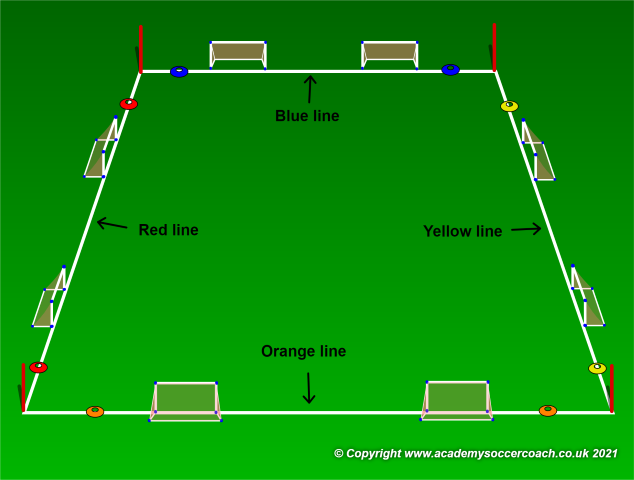
Two teams play against each other with the third team positioned around the marked area as shown in the below diagram. The players of the third team positioned on the perimeter have a ball ready at their feet.
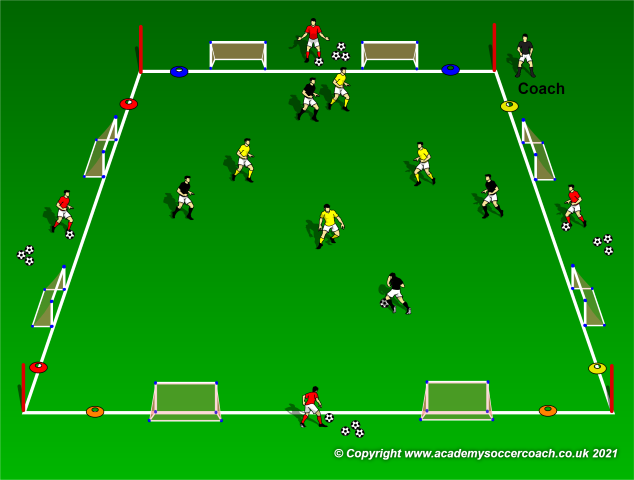
The game is on with one team aiming to score in one direction and the other team aiming to score in the opposite mini goalposts. The red players are the third team and they play with the team in possession. However the red players are not allowed to score.
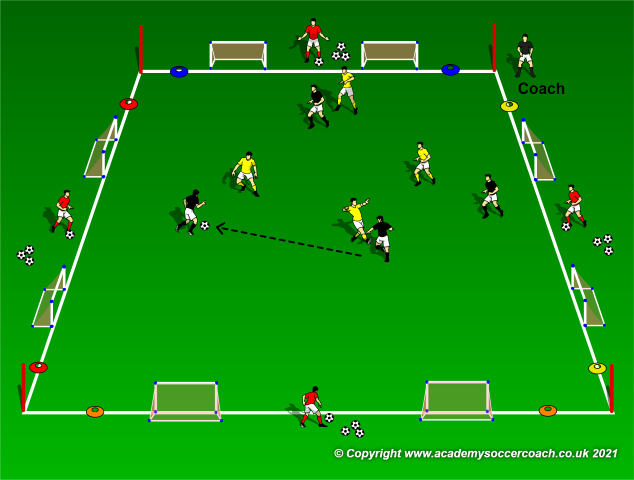
We can have the red players not participating in play so to overload further the players and play 4v4. In this case we should play with a shorter duration for each repetition.
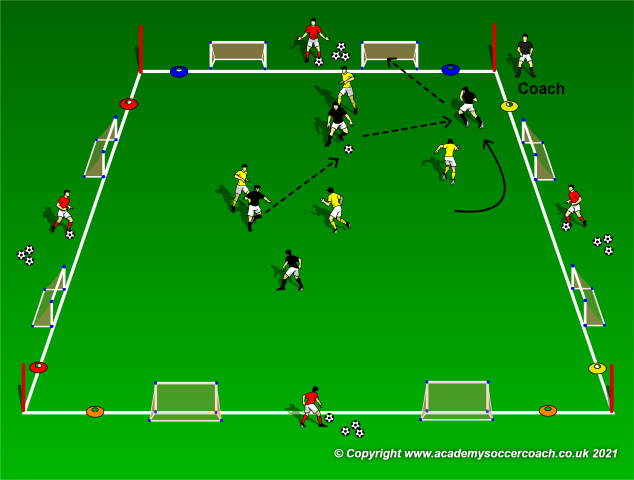
A goal is scored! The team that scored the goal remains on the pitch but has to quickly defend against the red team. We can modify the game and have the coach calling the team who remains on the pitch even when a goal is not scored.
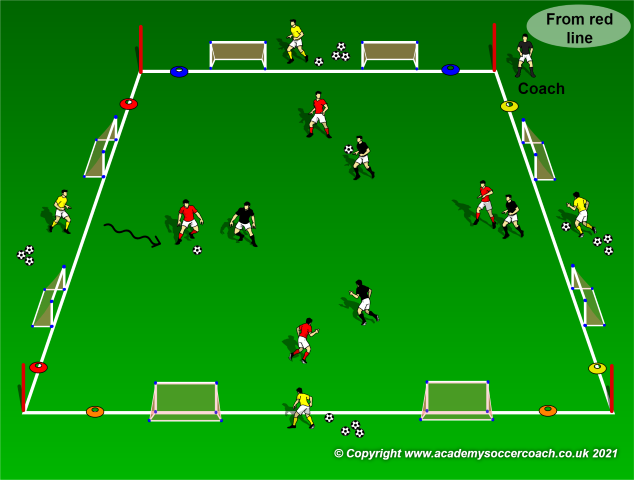
The coach calls out “Attack from the red line!” which means that the red team starts their attack from the red line, who should then protect the goals positioned on this line and attack the goals positioned on the opposite line (the yellow). The black team defends the two goals the red team are attacking on and scores in the two goals that the red team are defending. This means that in the previous game against the yellows the black team were defending the two goals positioned on the orange line and attacking the two goalposts positioned on the blue line. Now the orientation has changed for them. They defend the goals positioned on the yellow line and attack the two goals positioned on the red line. The yellow team (the team that conceded the goal) take the roles that the red team were previously occupying.
By Philip Cauchi
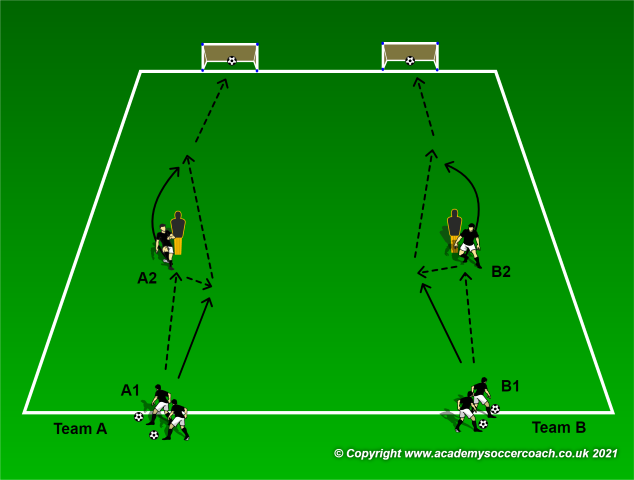
Relay Games For Soccer Endurance
By Philip Cauchi
Title: Relay Games For Soccer Endurance
Aim: To develop soccer-specific endurance
Introduction: The following are three relay games that target the development of soccer-specific endurance. Although personally I am more in favour of global and small-sided games to develop endurance, these might prove handy in introducing variety to the training routine, to maintain the interest and motivation levels of the players.
Relay game 1: Dribbling course plus finish on mini goal post.
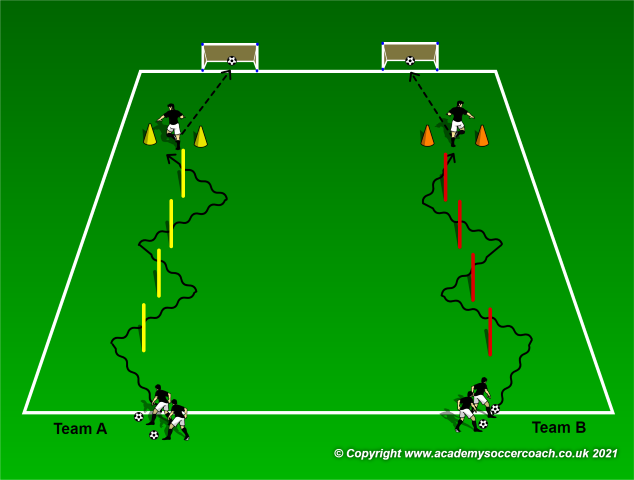
Organization: The team should be divided into two equal teams (team A and team B). Each team has four poles positioned one yard in front of each other. A gate should be positioned one yard behind the last pole and three yards from the mini goal post.
Description: The front player of each team dribbles around the poles prior to dribbling through the gates and finishes on the mini goal post. Immediately another player from the same group starts his/her turn. It is forbidden to have two players from the same team taking part simultaneously. Sequence is continued after the time period is over or the maximum amount of goals are scored. The winner is the team that has scored the most number of goals.
Technical development:
Dribble the ball using both feet.
Kick with accuracy.
Relay game 2: Passing combination prior to finish on goal.

Organization: The team should be divided into two equal teams (team A and team B). Each team has a mannequin positioned ten yards in front of the player with the ball (A1 and B1). The second player should be positioned with his/her back to the mannequin (A2 and B2).
Description: The player with the ball passes to the second player who returns the ball in space and then spins around the mannequin to receive the return pass prior to finishing on the mini goal. A1 and B1 take the place of the player with his/her back to the mannequin (A2 and B2) while the latter collects the ball and goes back in line. Sequence is continued after the time period is over or the maximum amount of goals are scored. The winner is the team that has scored the most number of goals.
Technical development:
Passing with accuracy.
Spinning to attack the return pass played in the space.
Relay game 3: Diagonal passes to finish with accuracy.
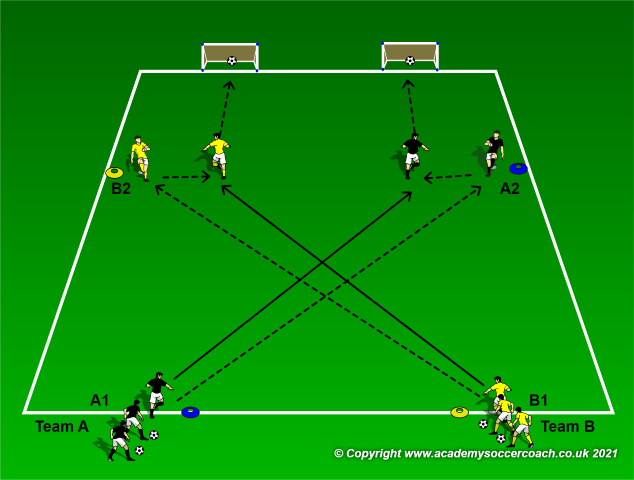
Organization: We have two groups of players where each group is further divided into two sub-groups (Group B – B1 and B2 and group A – A1 and A2). The subgroups are positioned twelve yards diagonally apart from each other. A mini goal post is positioned five yards in front of the last group (A2 and B2).
Description: Player 1 of each group (A1 and B1) passes diagonally to his/her teammate player 2 (A2 and B2). Player 1 follows his/her pass to receive the ball again to finish with accuracy on the mini goalpost. After each repetition player 1 takes the place of player 2, player 2 picks up the ball and joins the team’s line. Sequence is continued after the time period is over or the maximum amount of goals are scored. The winner is the team that has scored the most number of goals.
Technical development:
Passing with accuracy.
Quality of the lay-off pass.
By Philip Cauchi
